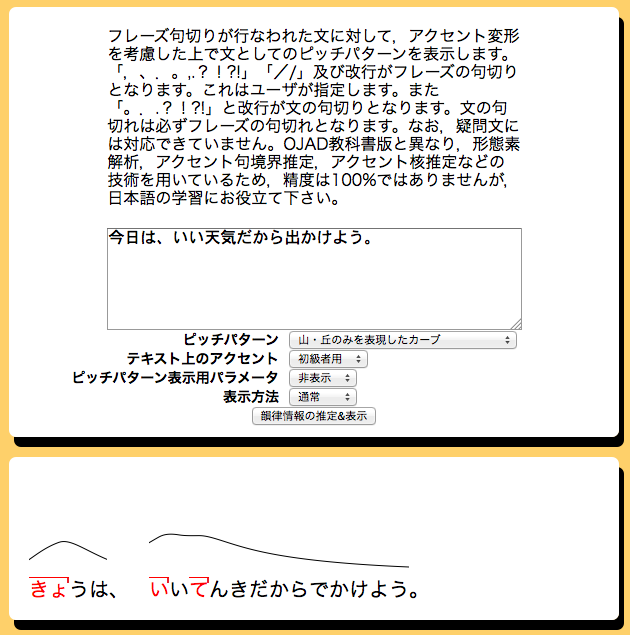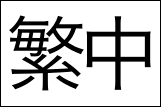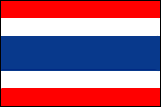Let's try Suzuki-kun
Overview of Suzuki-kun
If you enter a Japanese sentence into Suzuki-kun: Prosody Tutor, (1) the accent kernel position will be predicted and displayed and (2) the pitch contour when read aloud for the sentence will be predicted and displayed. This assumes that a strong focus is not placed on any one word. As a result, it does not support question sentences and other expressive or emotional sentences such as surprise.
To carry out the below, open the page "Suzuki-kun".
We recommend that you open up the page "Suzuki-kun" in another window and keep this "Let's try.." page open in this window while carrying out the tasks below.
Exercises
- In the text box for Suzuki-kun, enter "今日は、いい天気だから出かけよう。".
- In the list box, Pitch Contour select the item "Mountain-hill Contour". For more information on "Mountain-hill", see How to use Suzuki-kun. Keep the list box Accent Above Text at "Beginner".
- Click "Prosody Prediction".
- Resulting from this is a simple pitch contour for "今日は、いい天気だから出かけよう。".

- Putting a forward slash in the sentence in "今日は、いい天気だから出かけよう。" like 今日は、いい天気だから/出かけよう。" will break the sentence into two phrases. It is possible to manipulate the lengths of the phrases based on the learner level or reading-difficulty.
- Try entering a somewhat longer sentence. Here, we show you one of Suzuki-kun's weaknesses and propose a way around this problem.
Enter the sentences given below. It is okay to copy and paste them.
私は鈴木と申します。東京大学の学生です。スズキクンというプログラムを作りましたが、その後、中村君が改良してくれて、今のスズキクンが出来上がりました。このスズキクンは機械ですから、精度は100%ではありませんが、けっこう役に立つと思っています。普通の人にとって、アクセントやイントネーションのマークを付けることはやさしくないからです。少しぐらい間違いがあっても役に立つからいいと思う方、スズキクンと一緒に勉強しようと思う方、スズキクンと勝負しようと思う元気な学生さん、スズキクンを育ててもっと役に立つツールにしようと思う方たちの温かい支援をお願いします。」 - There are a few results that are not desirable
1: "私は" is "わたくしは" (reading error)
2: "100%" is "いちゼロゼロ" (reading error)
3: "勉強しようと思う方" is "べんきょうしようとおもうほう" (reading error)
4: The accent for "ふつうのひと にとって" is "ふつうのひとにとって" (accent error)
If you notice this kind of error, contact us and we will do our best do deal with it. However, we cannot guarantee prompt response time for fixing the problem so we would like to suggest the following for coping with this problem at this time. - Try finding a way around the problem by changing the input.
① Change「私」をto「わたし」(write in hiragana).
② Change「100%」to「百パーセント」(the system does not work well with arabic numerals so use kanji instead).
③ Change「方」to「かた」(write in hiragana). Change the list boxes Pitch contour and Accent Above Text to as simple a method as possible.
This means set Pitch contour to "Pitch Contour with Accent(Beginner)" or "Mountain-hill contour" to Accent Above Text (Beginner) to decrease the amount of accent information. When you choose "Pitch Contour with Accent (Advanced)" or "Advanced" (mark all accents) the accent information increases causing the number of mistakes in accent to possibly increase so this is best avoided.. - Considering reading difficulty...
5: For language learners, it will be a little too long to easily read so input "/".
By doing so, the modified sentence will be as below. Copy and paste this.
「わたしは/鈴木と申します。東京大学の学生です。スズキクンという/プログラムを作りましたが、その後、中村君が/改良してくれて、今のスズキクンが/出来上がりました。このスズキクンは/機械ですから、精度は/百パーセントではありませんが、けっこう/役に立つと思っています。普通の人にとって、アクセントや/イントネーションのマークを付けることは/やさしくないからです。少しぐらい間違いがあっても/役に立つからいいと思うかた、スズキクンと一緒に/勉強しようと思うかた、スズキクンと勝負しようと思う/元気な学生さん、スズキクンを育てて/もっと役に立つツールにしよう/と思う方たちの/温かい支援をお願いします。」 - By making modifications in this manner, the number of mistakes should decrease. 「ふつうのひとに」is still being mistaken, but the number of mistakes is reduced to just one location. Also, it should be possible for the listener to easily comprehend what the learner is saying even if this mistake is made.
This does not cope well with conversational sentences, words prefixed by 「お」, and compound words. That said, common compound nouns such as「東京貿易,川崎出版,福岡大学,品川高校」will work correctly. - It is possible to use Print-view as well. From the list box Display Type choose "Print-view", then click "Prosody Prediction". They will be displayed in a printable black and white screen that can be used as classroom materials.

- The above was done with the "Pitch Contour" list box set to "Mountain-hill Contour". We suggest you try setting this to "Pitch Contour with Accent (Beginner)" and "Pitch Contour with Accent (Advanced)" and then seeing the difference between the pitch contours for yourself. Select a level based on your Japanese language ability and the purpose for studying Japanese accent.
- We hope you can make use of Suzuki-kun for presentations or other purposes, but keep in mind that Suzuki-kun does have some weaknesses.
Let's try Word Search Let's try Verb Suffix Search Return to the top page















